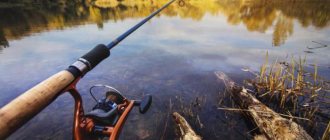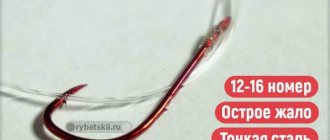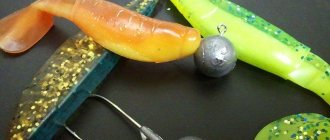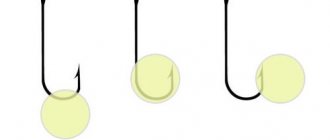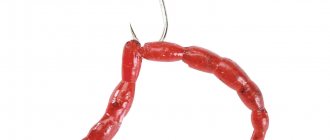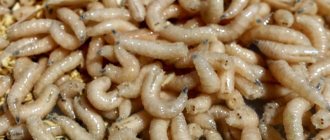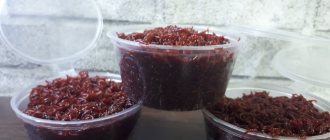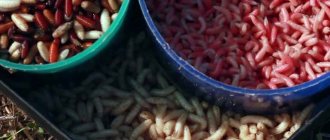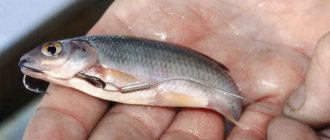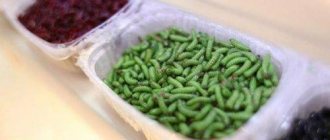Content
- Method No. 1. Watch your back!
- Method No. 2. Fish, live!
- Method number 3. Upper lip
- Method number 4. Underlip
- Method No. 5. Savvy
- What can you catch with live bait?
- What method do you use?
Friends, there is winter fishing ahead, trophy fishing, balancers, spoons and, of course, jigs. In this material I would like to discuss such an important point for fans of this type of fishing - how to properly attach live bait.
It would seem – what’s so complicated here? Left hook, right bait. Is the nozzle ready? But everything is not as simple as many beginners in this matter can imagine... If you touch vital organs, the baitfish will die and will not attract a predator... If it is difficult for it to move under water due to improper “installation” on the hook, its predator will won’t notice... You could go on for a long time listing all these “ifs” that, to one degree or another, can deprive you of the main thing - the trophy!
However, that’s why the fishing society exists, to share experiences, advice and observations. Today you will learn about the five most popular and effective methods of hooking live bait.
Basic methods of planting
Full insertion
This method involves threading the bait along the entire hook, even going onto the fishing line. With a ring mounted in this way, any fish, even very cautious ones, will fall for their favorite delicacy. Having swallowed the bait deeply, the hook is securely fixed in the throat of the fish.
"Bun" method
More than one worm is mounted on the fore-end. Let it be 2, 3, 4 or even more. Not a single fish can resist such a “bouquet” of delicious bait. It is good to use "bundles" of worms in a float tackle because they will gently sink to the water and, accordingly, under the water. When fishing with spinning rods, the “Bun” can hit the water and break into pieces.
Method "Eight"
The body of the bait covers the fore-end, but its ends stick out in different directions.
In parts
With this method, individual parts of the worm are placed on hooks. Due to the fact that the bait is cut into pieces, a specific smell emanates from the cut areas, which attracts the attention of the fish.
Wriggling bait
or more precisely, creating the appearance of a wriggling bait. The worm is placed on the tip of the hook, as they say, every other time. Part of the bait covers the metal of the tackle, part sticks out to one side.
Method No. 1. Watch your back!
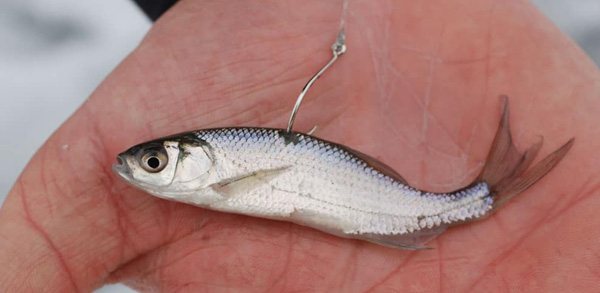
The most classic and frequently used method. When the hook pierces the back of the live bait so that it passes clearly under the dorsal fin.
However, in this case you need to be as careful as possible. If you hit or damage the ridge, the fish may be paralyzed or simply die. Experienced fishermen voice the figure - 3 millimeters. This is exactly how far you need to pierce the back below the fin.
Another important factor is behavioral characteristics in the natural habitat. That is, how the fish will behave in the water. Therefore, you need to bait the hook so that the live bait’s head “outweighs” a little. In this case, the live bait underwater will look like this; it will be looking for something at the bottom, swarming in the ground.
How to put bloodworms and maggots on a hook
Even experienced fishermen do not know exactly how best to place a bloodworm or maggot on a hook, so that on the next cast the fish will finally stop resting and start catching.
The question “how to best place bait on a hook” is one of thousands among experienced fishermen, in the context of their constant search for secret techniques for successful fishing. And for beginner fishing enthusiasts, this question is direct and essential - really, how to properly attach a bloodworm or maggot to a hook?
Place the bloodworm on the hook
The usual recommendations for planting bloodworms are as follows.
- Only extremely thin “crank” hooks are used. You shouldn’t even try to pull a moth onto a “carpokiller” hook.
- Bloodworms are selected before baiting. The largest larvae with the most pronounced fighting qualities are used. It bites much better on a moving larva.
- We replace the bloodworm on the hook with a fresh one in time. Then you can get the most from the reservoir.
Hanging
One bloodworm is taken with the fingers of one hand (be careful not to crush it). The hook is taken with the other hand. The bloodworm is then pierced with a sting approximately between 3 and 4 segments from its head. The hook is removed from the larva near the head itself, and it moves to the bend of the hook. That's all - the living creatures do not lose their vitality for a long time (about 15 minutes) and remain attractive to fish.
According to some anglers, the attractiveness of the bait will increase if a pair or three larvae are attached to the hook in a similar way. This is especially true when it comes to catching heavy fish.
A bloodworm hanging from a hook is good when the fish is moderately active and will greedily grab it, swallowing it along with the hook. But this rarely happens. Much more often, the fish carefully takes the mosquito larva by the tail and pulls it off the hook, leaving the angler with only empty hooks over and over again.
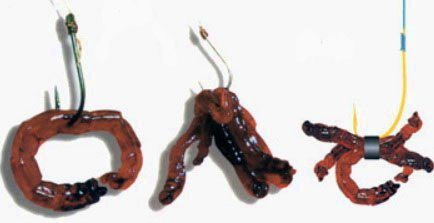
Stocking
With the weak, the method of baiting bloodworms with a “stocking” helps. It's easy to do. In the same way, the larva is pierced near the head, only this time the sting is directed towards its tail. With careful movements of the fingers, it is pulled onto the hook. Tail droop is minimized as much as possible, but the hook is not removed from the body. Now the fish has nothing special to pull off the larva, and it captures it immediately along with the hook.
Accidentally hitting
Everything is not bad, but such actions require a lot of time and sleight of hand. But what to do in a situation when the fish is really hungry and every second counts? Or when in the cold your fingers are hard to control? Or in a situation where your hands are shaking and you can’t even see one bloodworm? Then the method of attaching a bloodworm to the rescue comes to the rescue.
The bloodworm ball is grabbed with two fingers. Then, the hook is pierced several times through the entire ball, and within a second, one or several bloodworms or parts of them are somehow picked up on it. And such a bait is sent into the water (under the ice), and with a passionate bite, the fish are caught no worse than if the fisherman very diligently put on the bloodworm for several minutes and examined the results of his work.
Big bunch - big catch
To catch large fish, anglers sometimes use a whole bunch of bloodworms tied to a hook. For example, this is often done when fishing for bream. A small piece of nipple elastic will help secure the bunch of bloodworms to the hook. When fishing, the entire bunch is planted in seconds - just insert the sting into the nipple, which already contains several bloodworms. And the thickness of the hook now does not play any role, which is a big plus for catching large fish.
But how to thread a bloodworm into a nipple, and even a whole bunch?
How to thread a bloodworm through an elastic band
The simplest device that every angler can make with his own hands will help. Take a plastic handle and throw out all the guts. The body is cut with a knife “on an oblique”, so that at its cut end something in the form of a scoop with a pointed nose is formed. Then a short piece of elastic is pulled onto this body through its sharp part. Several bloodworms are placed on the scoop, and the nipple is pulled off the handle, simultaneously capturing all the bloodworms located “in the scoop.”
Having spent half an hour at home preparing the bunches and n-number of elastic bands, the fisherman will come to the pond, as they say, fully armed. By the way, the nipple, after the bloodworm is eaten by the fish, can be used for the second pass.
If bloodworms can be planted in any way you like - “as it turns out” or as your imagination dictates, and at the same time, not without reason to count on a bite, then with maggots the situation is somewhat more complicated. One circumstance adds special features to its use - this larva has a very hard and durable skin.
Live maggot
When the bite is sluggish (and this means often), it is desirable that the maggot remains alive, and even retains its agility. This provokes fish better than a motionless dead larva. But the maggot can retain its vitality provided that its insides are not damaged by the hook. Therefore, the classic recommendation for baiting a maggot looks like this: - use the tip of a hook to pry the skin near the head between the so-called “eyes”, then bring the sting out under the skin and move the maggot towards the forearm.
This way you can plant several maggots to catch large fish. After biting (catching a fish), it often happens that the maggot on the hook remains intact, alive and fidgety, and is suitable for re-casting.
Baiting options
A maggot can very easily take revenge on a fisherman for being hooked to be eaten by fish. It wraps itself around the hook and simply covers the sting with its body. Further: - the fish bites, the float quickly moves away to the side with a dive, the fisherman even waits to spot the carp (whale) for sure, aaaand... and on the hook there is only a smiling maggot.
If the larva covers the sting with its hard skin, then it will not be possible to hook the fish. Therefore, when the bite is confident, fishermen bait the maggot with a stocking, after which it quickly dies. Or, many fishermen recommend doing a combination of baiting techniques - a couple of larvae are put under the skin to keep them alive, and then a maggot pierced through its length is placed near the sting.
Whenever baited, the hook tip is always removed from the body of the blowfly larva, and remains free for hooking fish.
How to make larvae immobile
Sometimes, for conditions of confident biting on bait, or when there is not enough time at competitions, anglers specially use killed larvae so that they do not interfere with the bait with their fidgetiness and do not make idle hooks. Maggots are killed with heat. In order not to cook it over a fire, the larvae are first cooled (spring water), then immediately placed in hot water (tea from a thermos). After this procedure, the fisherman confidently throws maggots on a hook towards the ever-hungry mouth of the long-awaited carp.
Method No. 2. Fish, live!

This equipment option is considered one of those that allows you to keep the fish alive on a leash for as long as possible. Precisely alive, since with such equipment it is not injured.
You will need a double that is held with the forend through the mouth and out through the operculum. Well, then all that remains is to tie the leash and off you go to catch some trophy pike!
How to rig a worm to catch bream
Bream - this white fish also has a rather large mouth, but to successfully catch it, you also need to take into account some features.
- The best bait for bream is a dung worm. There are three ways to attach it to the hook:
- When fishing with bottom gear, the worm can be pierced in 2-3 places.
- The second method of putting on a worm can be compared to putting on a sock. That is, the entire body of the worm is strung on a hook, just like a sock on a foot. This is often used for float fishing.
- In the latter method, the worm is torn into pieces and placed on a hook. This method is very attractive to fish because it looks like a whole bunch of crawlers. Of course, you can not tear the worm apart, but use several whole ones at once. But bream is unable to open its mouth that much.
- What should the hook be like?
- First of all, spicy. A dull hook is unable to reliably hook a fish. You shouldn’t waste your money on replacing unsuitable gear.
- If you use a worm as bait, then it is better to take a hook with a long or medium shank.
- If you are planting mastyrka, corn or pearl barley, choose a medium-sized forend.
- For maggots, hooks with shanks from smaller to medium sizes are suitable.
- For bloodworms, take the middle number.
- The thickness of the hook should be medium. A thin sting gives an advantage to the bait - it is easily strung and remains mobile (if the bait is of a non-vegetative type), but loses when hooking bream. It can easily break off, breaking such a hook. A thick sting wins in hooking, but it is difficult to put the bait on such a bait.
- The bend can be one of three classic types: straight, inward and to the side; or the shape of a fly hook.
Several ways to properly mount a worm:
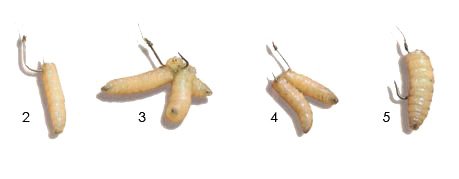
What can you catch with live bait?
And here is a vivid example of how, with the correct use of live bait, you can catch a serious trophy. Here on the website, in the “Photo Gallery” section you can find this photo.

In it, site user Roman (romrom) demonstrates a 13-kilogram pike, which he caught on a zherlitsa. Here's what Roman himself says:
— The live bait was small, only 12-15 cm. The perch was from the same lake where this beauty was caught. To get it out, I had to drill out 4 holes around the main one.
How to pipe the dough securely
As already mentioned, the denser the consistency of the dough, the more securely it holds on the hook, but this is not the best option.
Another method is to add a small amount of cotton wool to the soft dough. At the same time, the nozzle does not change its consistency, but holds tightly thanks to the many fine fibers.
How to mix dough with cotton wool:
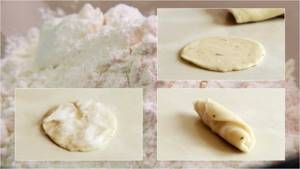
Dough with added cotton wool
- The dough is rolled out;
- Covered with cotton wool;
- Rolls up into a roll;
- Mix thoroughly until the cotton wool is evenly distributed.
The next method is to use “dough spring” hooks. These are ordinary hooks equipped with a thin spring, which serves to hold the soft bait. They can be found on sale or made yourself.
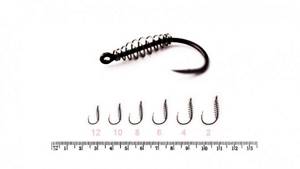
Hooks with a spring are great for semolina mash, various types of mastyrka, and any soft dough. And to clean the spring from the remnants of the nozzle, it is useful to have a small brush with you.
Useful video:
How to attach a worm to carp
Carp, or carp, is an unpretentious fish. He can eat everything: Various worms, insects, as well as rotten plants and fruits, but most of all he loves the shoots of young reeds. But at the same time, we will only consider bait such as worms:
- For carp, you can attach a whole bunch of crawlers, this will serve as an excellent bait for it.
- Another great bait is the “sandwich”. Place the worm on the hook along with the corn. Carps probably love this more than a bunch of crawlies.
- You can plant the worm using the “stocking” method, that is, piercing it onto the sting through the entire body.
- The standard method is to pierce the worm in 2-3 places.
The hook also plays an important role:
First of all, it must be strong and sharp. A blunt hook will easily dislodge prey if it gets caught at all.
- The hook should be appropriate for what you are trying to catch, as well as the size of the bait. It is better to choose a medium thickness, because... carp is not a very large fish, and therefore does not need large bait.
- For a pond that has a lot of branches at the bottom, hooks with a closed tip will do. This is necessary so that the hook does not cling to the bottom. But if the bottom is clean, then take one with an “open tip”; this type of hook is more straight, i.e. open, more distant from the fore-end.
Sandwich with corn and worm
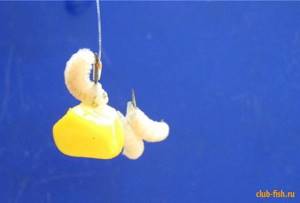
Sandwich with corn and maggots
"Old-fashioned" ways to put a worm on a hook
In practice, there are 3 ways to put a worm on a hook. Which one will be preferable at the moment is checked directly during fishing.
"Stocking"
The classic method, which was learned in childhood. Provides catching of any fish. It is used for planting a whole worm or its parts.
We bring the hook tip to the body of the worm in the middle or from the end and prick it.
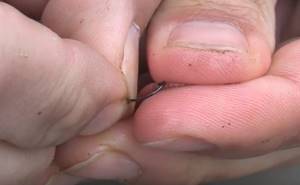
Next, carefully pull the bait onto the hook with a “stocking” until the very tip. The sting can be removed or brought under the very edge.
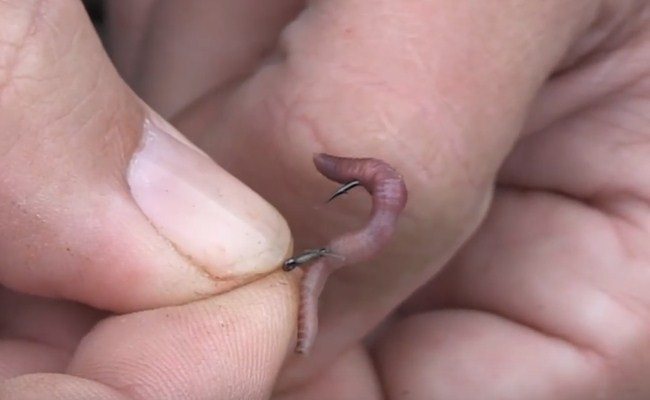
Using a through puncture method in two or three places
A whole worm is taken and pierced first in one place, then in another. The output of the tip is at your discretion. If you wanted to hide it, after the second puncture we tighten it with a “stocking”.
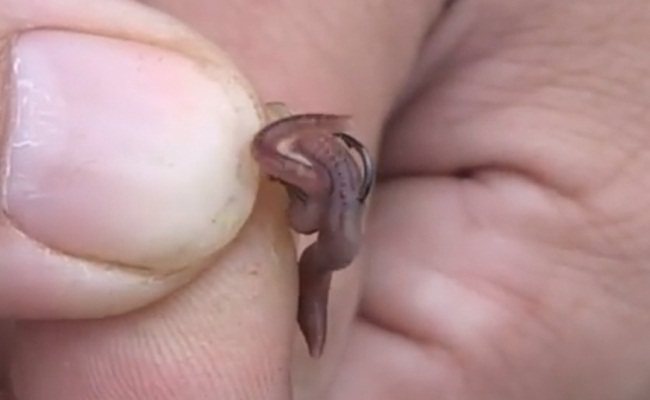
If the worm is long, it is pierced a third time.
